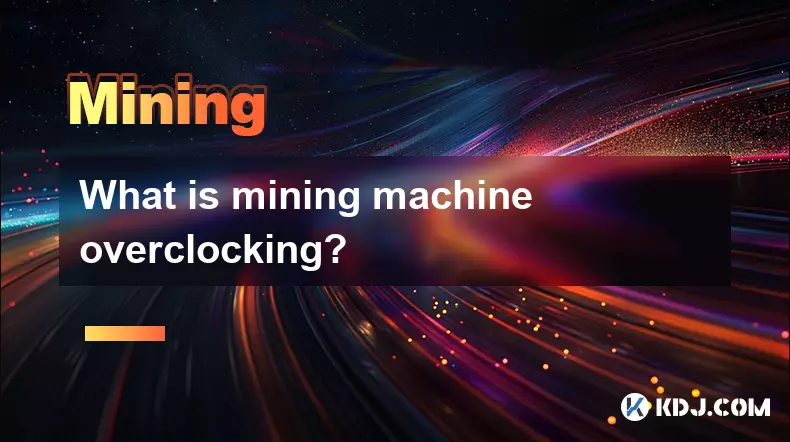-
 bitcoin
bitcoin $109547.008142 USD
0.04% -
 ethereum
ethereum $4011.838726 USD
-0.05% -
 tether
tether $1.000402 USD
-0.01% -
 xrp
xrp $2.798606 USD
0.88% -
 bnb
bnb $970.877944 USD
1.39% -
 solana
solana $202.237275 USD
-0.95% -
 usd-coin
usd-coin $0.999673 USD
0.00% -
 dogecoin
dogecoin $0.229294 USD
-1.15% -
 tron
tron $0.336370 USD
-0.45% -
 cardano
cardano $0.777260 USD
-1.66% -
 hyperliquid
hyperliquid $45.503019 USD
1.73% -
 ethena-usde
ethena-usde $1.000362 USD
0.01% -
 chainlink
chainlink $20.785303 USD
-1.10% -
 avalanche
avalanche $28.755822 USD
-0.11% -
 stellar
stellar $0.358303 USD
-0.48%
What is the best CPU for mining Monero (XMR)?
Monero mining favors CPUs with high core counts, large caches, and AES-NI support, making processors like the AMD Ryzen 9 5950X and 7950X top choices for efficient, profitable mining in 2024.
Aug 11, 2025 at 01:56 pm

Understanding Monero Mining and CPU Dependency
Monero (XMR) is a privacy-focused cryptocurrency that relies on the Cryptonight proof-of-work algorithm, which is specifically designed to be CPU-friendly and resistant to ASIC mining. This means that unlike Bitcoin or Ethereum, where specialized hardware dominates, Monero mining can still be efficiently performed using consumer-grade central processing units (CPUs). The algorithm favors high core counts, large cache sizes, and strong multi-threading performance. As a result, selecting the right CPU becomes a critical factor in maximizing mining efficiency and profitability.
Because Monero emphasizes decentralization and accessibility, it intentionally levels the playing field between individual miners and large-scale operations. This makes CPUs with strong single-thread performance and large L3 cache particularly effective. The mining process involves solving complex cryptographic puzzles that benefit from fast memory access and parallel processing capabilities. Therefore, CPUs with high IPC (Instructions Per Cycle) and support for AES-NI instruction sets are essential for optimal performance.
Key CPU Features That Impact Monero Mining Performance
When evaluating the best CPU for Monero mining, several hardware characteristics directly influence hash rate and power efficiency:
- Number of Cores and Threads: More cores allow for greater parallel processing, increasing the number of hashes computed per second. CPUs with 8 or more cores tend to perform significantly better.
- L3 Cache Size: The Cryptonight algorithm uses a 2MB scratchpad that fits within the L3 cache. CPUs with larger L3 caches (16MB or more) reduce memory latency and improve mining speed.
- Clock Speed and IPC: Higher base and boost frequencies, combined with efficient architecture, contribute to faster instruction execution.
- AES-NI Support: This hardware acceleration for encryption tasks is crucial. Without AES-NI, mining performance drops drastically.
- Power Consumption (TDP): A lower TDP with high hash rate yields better efficiency, reducing electricity costs.
These factors must be balanced to determine the best value per watt and per dollar spent.
Top CPUs for Monero Mining in 2024
Several CPUs stand out due to their performance-to-efficiency ratio in Monero mining:
- AMD Ryzen 9 5950X: With 16 cores and 32 threads, this CPU delivers one of the highest hash rates, often exceeding 60,000 H/s using optimized mining software like XMRig. Its large 64MB L3 cache and strong IPC make it a top-tier choice.
- AMD Ryzen 9 7950X: Based on the Zen 4 architecture, this processor offers improved efficiency and performance. It achieves similar or slightly higher hash rates than the 5950X while consuming less power under load.
- AMD Threadripper 3970X: Featuring 32 cores and 64 threads, this workstation CPU can achieve over 110,000 H/s in multi-CPU configurations. However, its high TDP (280W) and cost make it less efficient for small-scale miners.
- Intel Core i9-13900K: Despite being an Intel chip, this CPU performs well with 24 cores (8P + 16E) and high clock speeds. It reaches around 55,000 H/s but consumes more power than AMD counterparts.
- AMD Ryzen 7 5800X3D: Although designed for gaming, its massive 96MB L3 cache gives it an edge in latency-sensitive tasks. However, its 8-core limit caps its mining output compared to higher-core models.
Among these, the Ryzen 9 5950X and 7950X offer the best balance of performance, availability, and efficiency.
Setting Up a Monero Mining Rig with Your CPU
To begin mining Monero using your selected CPU, follow these detailed steps:
- Download XMRig, the most widely used open-source Monero miner, from the official GitHub repository (https://github.com/xmrig/xmrig).
- Install the miner by extracting the ZIP file to a dedicated folder on your system.
- Open the
config.jsonfile using a text editor like Notepad++. - Locate the 'pools' section and enter a Monero mining pool address such as pool.supportxmr.com:3333.
- Enter your Monero wallet address in the 'user' field. Ensure it starts with '4' or '8' for standard or integrated addresses.
- Set 'pass' to 'x' unless the pool requires a specific password.
- Adjust the 'cpu' section to optimize thread usage. For a 16-core CPU, set 'threads': 16 and 'affinity': 0xAAAAAA (to alternate core usage and reduce heat).
- Enable 'huge-pages': true and 'asm': 'auto' for performance gains.
- Save the configuration and run
xmrig.exe(Windows) or./xmrig(Linux).
Monitor the console output to confirm connection to the pool and view real-time hash rate. Use tools like HWiNFO to track CPU temperature and power draw.
Optimizing CPU Performance for Maximum Hash Rate
To extract the best possible performance from your mining CPU, consider the following optimizations:
- Enable AES-NI in BIOS: Navigate to CPU settings and ensure AES-NI or Cryptographic Support is enabled.
- Disable SMT/Hyper-Threading (if beneficial): Some users report better efficiency with SMT off due to cache contention. Test both configurations.
- Overclock the CPU and Infinity Fabric (AMD): Increase base clock and adjust VCore cautiously. For Ryzen, tune the FCLK and MCLK to 2000MHz for optimal memory performance.
- Use Low-Latency DDR4 RAM: Cryptonight benefits from fast memory. Use 3600MHz CL16 or better RAM kits.
- Undervolt the CPU: Reduce VCore slightly to lower power consumption without sacrificing stability.
- Run Windows in Performance Mode or use Linux: Linux typically offers lower overhead. Use Ubuntu Server with XMRig compiled from source for best results.
- Isolate mining processes: Disable background apps, Windows updates, and unnecessary services to free up CPU cycles.
Each of these adjustments can cumulatively improve efficiency by 10–20%.
Frequently Asked Questions
Can I mine Monero with a laptop CPU?Yes, but most laptop CPUs have limited cooling and power delivery. You may achieve 5,000–10,000 H/s on high-end mobile processors like the Ryzen 9 5900HX, but thermal throttling will reduce sustained performance. Mining on laptops is not recommended for long-term use due to heat stress.
Does mining Monero damage my CPU?Mining does not inherently damage a CPU if temperatures are kept under control. Ensure your cooling solution can handle continuous 100% load. Keep CPU temps below 85°C to avoid long-term degradation.
Is it still profitable to mine Monero with a CPU in 2024?Profitability depends on electricity cost and hardware efficiency. At $0.10/kWh, a Ryzen 9 5950X might generate $0.30–$0.50 per day after power costs. Use online calculators like WhatToMine to estimate earnings based on current XMR price and network difficulty.
Do I need a GPU to mine Monero?No. Monero is designed to be mined efficiently on CPUs. While some GPUs can run XMRig, they are generally less efficient per watt compared to high-core-count CPUs. The network algorithm favors CPU architecture, making GPUs non-competitive.
Disclaimer:info@kdj.com
The information provided is not trading advice. kdj.com does not assume any responsibility for any investments made based on the information provided in this article. Cryptocurrencies are highly volatile and it is highly recommended that you invest with caution after thorough research!
If you believe that the content used on this website infringes your copyright, please contact us immediately (info@kdj.com) and we will delete it promptly.
- Ethereum's Price Dance: Will Crypto Rallies Keep the Music Playing?
- 2025-09-29 08:25:12
- Crypto Staking Spotlight: BlockDAG's Referral Revolution Outshines Avalanche & Meme Coin Hype
- 2025-09-29 08:45:16
- BlockDAG, SUI, Chainlink: Navigating the Crypto Landscape in 2025
- 2025-09-29 08:25:12
- XRP Price Gears Up: Breakout Signals and What to Watch
- 2025-09-29 08:30:01
- Bitcoin, Gold, and Digital Assets: Navigating the New Financial Frontier
- 2025-09-29 08:45:16
- UN Embraces Blockchain: A Pension Fund Success Story and a Glimpse into the Future
- 2025-09-29 08:50:01
Related knowledge

The difference between staking and mining
Sep 24,2025 at 05:18am
Understanding Staking in the Cryptocurrency Ecosystem1. Staking involves holding funds in a cryptocurrency wallet to support the operations of a block...

How to participate in testnet mining?
Sep 22,2025 at 09:18am
Understanding Testnet Mining in the Crypto Ecosystem1. Testnet mining is a method used by blockchain developers to simulate real-world conditions on a...

How to dispose of abandoned mining machines?
Sep 19,2025 at 08:19pm
Assessing the Condition of Abandoned Mining Rigs1. Begin by inspecting each mining machine for visible damage, corrosion, or missing components. Machi...

How to identify high-quality mining pools?
Sep 21,2025 at 03:19pm
Reputation and Track Record1. A mining pool’s reputation is built over time through consistent performance and transparency. Pools that have operated ...

Advantages of decentralized mining pools
Sep 20,2025 at 04:36pm
Enhanced Security and Resistance to Censorship1. Decentralized mining pools operate on blockchain-based smart contracts, eliminating the need for a ce...

What is mining machine overclocking?
Sep 21,2025 at 07:19pm
Understanding Mining Machine Overclocking1. Mining machine overclocking refers to the process of increasing the operating frequency of a cryptocurrenc...

The difference between staking and mining
Sep 24,2025 at 05:18am
Understanding Staking in the Cryptocurrency Ecosystem1. Staking involves holding funds in a cryptocurrency wallet to support the operations of a block...

How to participate in testnet mining?
Sep 22,2025 at 09:18am
Understanding Testnet Mining in the Crypto Ecosystem1. Testnet mining is a method used by blockchain developers to simulate real-world conditions on a...

How to dispose of abandoned mining machines?
Sep 19,2025 at 08:19pm
Assessing the Condition of Abandoned Mining Rigs1. Begin by inspecting each mining machine for visible damage, corrosion, or missing components. Machi...

How to identify high-quality mining pools?
Sep 21,2025 at 03:19pm
Reputation and Track Record1. A mining pool’s reputation is built over time through consistent performance and transparency. Pools that have operated ...

Advantages of decentralized mining pools
Sep 20,2025 at 04:36pm
Enhanced Security and Resistance to Censorship1. Decentralized mining pools operate on blockchain-based smart contracts, eliminating the need for a ce...

What is mining machine overclocking?
Sep 21,2025 at 07:19pm
Understanding Mining Machine Overclocking1. Mining machine overclocking refers to the process of increasing the operating frequency of a cryptocurrenc...
See all articles










































































